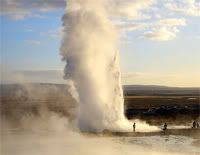
Arguably Google has done far more to change civilization than the Gutenberg Press, in bringing free research to the world and thus opening up the vast wealth of all of our collective intellectual endeavours to all of us. Now they would appear to be performing a similarly game-changing service: investing in a neglected, cheap, clean and abundant source of energy.
Google plans to invest $11 Million in EGS (deep) Geothermal power this year. (By contrast, the Bush DOE has once again zeroed out Geothermal investment.) "It's a big resource, it's got a good cost curve, and it's not getting enough attention," says Dan W. Reicher, Google.org's director of climate and energy initiatives. This investment in Geothermal would be a good fit with Google's previous investments in electric vehicles, because an easily extractable byproduct of Geothermal drilling is lithium.
Forbes says that a study from the Massachusetts Institute of Technology estimated EGS could open up an additional 100,000 megawatts of generating capacity in the U.S. by 2050, up from 2,000 MW today. That could mean 800 million megawatt-hours of more power every year, up from just 15 million megawatt-hours today.
Initial extraction costs (including construction, development and financing) would be 9 cents, even with no subsidies that might well become available under a hopefully more pro-renewable administration. Once production is underway, costs drop by more than half.
The ongoing cost for Geothermal power is estimated at 4 cents. This compares extremely well with new nuclear power at 18 to 30 cents, or natural gas at 9.3 cents and would be almost as cheap as coal, currently at about 2 cents, a figure which is likely to increase as carbon legislation forces older facilities to either close or retrofit for carbon capture.
The cost of Geothermal is falling faster than the cost of fossil fuels, including coal. While geothermal’s costs have steadily decreased throughout the years, those of natural gas have increased recently, often experiencing boom and bust type cycles that can negatively impact the economy. EIA analysis places geothermal energy at a lower levelized cost than Natural Gas Combined-Cycle, Wind, Open-Loop Biomass, Nuclear, Solar Thermal, and Photovoltaic (with costs increasing in the order in which they are listed).
Most industry experts agree that Geothermal is one of only a few alternative technologies that will compete economically with polluting technologies in the near term.
Photo By Guillermo Santamaria


